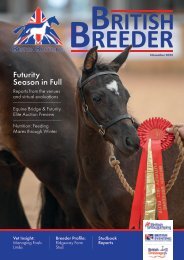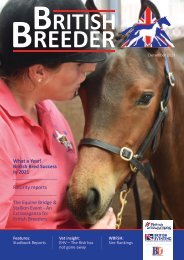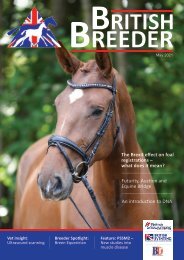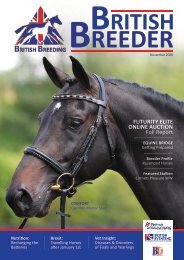British Breeder Magazine May 2020
Magazine for breeders of British bred sport horses. Includes breeding industry news, updates, interviews, profiles and reports.
Magazine for breeders of British bred sport horses. Includes breeding industry news, updates, interviews, profiles and reports.
Create successful ePaper yourself
Turn your PDF publications into a flip-book with our unique Google optimized e-Paper software.
Feature - FEEDING ARTICLE<br />
Protein Digestion<br />
The process of digestion essentially frees<br />
amino acids from dietary protein. It<br />
begins in the stomach with the release of<br />
hydrochloric acid (HCl) and the inactive<br />
enzyme, pepsinogen, which is activated<br />
by HCl to pepsin. Pepsin breaks down<br />
protein bonds, creating shorter chains<br />
of amino acids and some free amino<br />
acids, which then empty into the small<br />
intestine where they are broken down<br />
further into smaller fragments (peptides)<br />
by proteolytic enzymes, secreted by the<br />
pancreas, into the duodenum.<br />
Protein requirements increase with workload<br />
Further digestion occurs along the small<br />
intestine where the end products are<br />
absorbed and amino acids are then<br />
transported in the blood to the liver.<br />
The liver plays an important role in<br />
monitoring the amino acid levels and<br />
adjusting rates of metabolism to suit<br />
the body’s requirements. As mentioned<br />
previously, non-essential amino acids<br />
can be formed in the liver, while waste<br />
nitrogen from excess amino acids<br />
is removed as ammonia, which is<br />
converted to urea and excreted, via the<br />
kidneys, in urine.<br />
Protein Quality<br />
The quality of protein is often determined<br />
by its digestibility and the proportion of<br />
essential amino acids present relative to<br />
its total protein content. Although there<br />
are lots of ingredients which supply<br />
protein, when it comes to appropriate<br />
sources for the horse, quality is more<br />
important than quantity.<br />
In the horse’s body, lysine is what is<br />
known as the “first limiting amino acid”,<br />
which means that protein can only be<br />
utilised in accordance with the levels of<br />
lysine present and any deficiencies in this<br />
amino acid will impair protein synthesis.<br />
As such, lysine rich feedstuffs would be<br />
considered higher quality and more<br />
suited to the horse as protein sources<br />
yet many plant protein sources supply<br />
too little of one or more of the essential<br />
amino acids.<br />
Cereal Protein<br />
Cereals themselves, for example, are a<br />
poor source of protein but their byproducts,<br />
like distillers’ grains, supply<br />
more concentrated levels, though their<br />
amino acid composition will still be<br />
poor. Alfalfa, alfalfa meal, grass meal,<br />
peas and soya beans are all common<br />
feed ingredients, which come under<br />
the umbrella of forages or legumes.<br />
Legumes, such as alfalfa, peas and<br />
beans, typically have good crude<br />
protein levels (generally exceeding 14%<br />
dry matter), while grasses are typically<br />
lower in crude protein in comparison.<br />
The crude protein content of grass varies<br />
depending on the stage of growth and is<br />
usually at its highest when the plant is in<br />
a vegetative stage and lowest when in a<br />
late stage of maturity. Well maintained<br />
pasture can contain as much as 14-20%<br />
crude protein, on a dry matter basis,<br />
during growing season, so any equines<br />
whose forage (grass, hay, haylage) is<br />
restricted to control calorie intake, will<br />
be missing out and need additional<br />
protein sources in the form of alfalfa<br />
or an appropriate compound feed or<br />
balancer.<br />
Protein Rich<br />
Soya beans are common in horse<br />
feed due to their desirable amino acid<br />
content. When oil is extracted, the meal<br />
that remains is high in protein and soya<br />
bean meal is the richest plant source of<br />
protein and lysine available for use in<br />
the UK. Raw soya beans contain what<br />
are known as “anti-nutritional factors”<br />
which must be inactivated during the<br />
feed manufacturing process. To achieve<br />
this, heating (micronising) or extruding is<br />
essential, yet too much heat can damage<br />
the protein and reduce amino acid<br />
availability.<br />
Other seed meals, like sunflower, are<br />
also high in protein but these are<br />
comparatively lower in lysine, making<br />
them less desirable for the horse. If<br />
these protein sources are used or, if the<br />
nature of the product restricts the use of<br />
more suitable protein sources, it may be<br />
necessary to balance the amino acid<br />
profile using an amino acid additive<br />
in a feed’s formulation. Manufacturers<br />
have access to feed-grade sources of<br />
several individual amino acids, which<br />
can be synthesised in either the D or<br />
L form, (variations of the molecule’s<br />
configuration) so you may see ‘L-Lysine’<br />
listed as a feed ingredient, meaning<br />
lysine has been added.<br />
Milk Powder<br />
Milk protein is considered a high quality<br />
protein source due to its amino acid<br />
profile and its high digestibility. The<br />
protein in mare’s milk declines over the<br />
course of lactation and, once the foal<br />
reaches 2 to 3 months of age, most<br />
of its dietary protein will be derived<br />
from other sources. Creep feeds and<br />
weanling diets may contain milk proteins<br />
to help the youngsters’ transition to<br />
plant-based sources. Milk powder is<br />
rarely used as the main protein source<br />
for adult horses as, unless a milk-based<br />
diet is maintained from weaning, lactose<br />
enzyme activity is lost so excessive<br />
amounts in the diet may lead to digestive<br />
upset, such as diarrhoea.<br />
54 | BRITISH BREEDER















